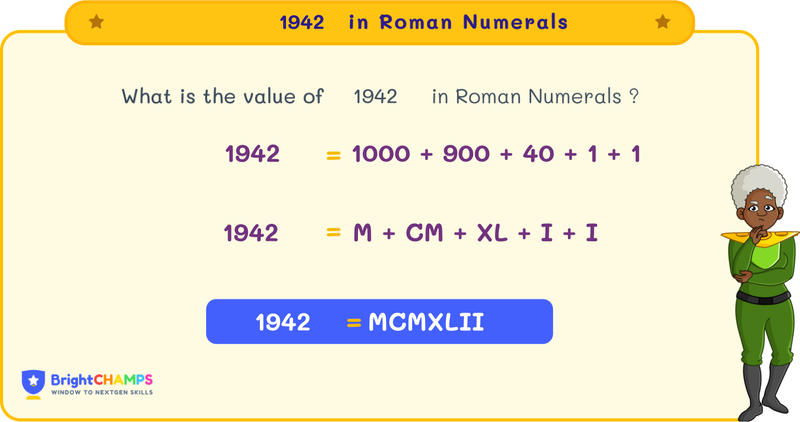
 173 Learners
173 LearnersLast updated on May 26th, 2025

1942 in Roman Numerals

Roman numerals are the way of expressing numbers using symbols. I, V, X, L, C, D, and M are the symbols we use. Roman Numerals are used in royal titles, book names, sequences, and so on. Here we will be discussing Roman Numerals, rules, and examples.
What is 1942 in Roman Numerals?
The royal titles, such as Henry I, Henry II, and so on. Have you noticed the names and wondered what these symbols (I and II) represented? Those are the Roman Numerals.
Earlier people used to count using fingers, sticks, bones, etc. to count earlier. When life became complex, a standard form was required to count. Ancient Romans used the Roman Numeral system to count. I (1), V (5), X (10), L (50), C (100), D (500), and M (1000) are the symbols we use to count.
In Roman Numerals, we use MCMXLII to represent 1942. Here, M is 1000, CM is 900, XL is 40, and II is 2. Let’s learn more about Roman numerals and how we write them.

Struggling with Math?
Get 1:1 Coaching to Boost Grades Fast !

Basic Rules for 1942 in Roman Numerals
There are certain basic rules to write a number in Roman Numerals. In this section, let’s discuss some basic rules that need to be remembered when writing a number in Roman numerals.
Rule 1: Addition Method
The addition method is used when the smaller number is placed after the larger number. For example, VI → V + I → 5 + 1 = 6
Rule 2: Repetition Method
To write a large number, there are certain Roman Numerals that can be repeated up to three times. III → 3.
Rule 3: Subtraction Method
If a small number is followed by a large number in Roman Numerals, we subtract the smaller number from the large number. For example, IX → X - I → 10 - 1 = 9
Rule 4: Limitation Rule
The symbols cannot be repeated more than three times, and some symbols like V, L, and D cannot be repeated. For example, we won't write VV for 10; instead, we use X, and 8 is written as VIII, not IIIIIIII.
How to Write 1942 in Roman Numerals
Let’s now learn how to write 1942 in Roman Numerals. Follow these methods to write the number in Roman Numerals.
- By Expansion Method
- By Grouping Method
1942 in Roman Numeral by Expansion Method
In the expansion method, based on the place value, the number is broken down. In this section, we will learn how to write 1942 in Roman numerals using the expansion method. To write 1942 in Roman Numerals, follow the steps:
Step 1: Break down the number based on the place value. Place values are thousands, hundreds, tens, and ones. For 1942, we write it as 1000 + 900 + 40 + 2
Step 2: Converting the number into Roman Numerals
- 1000 in Roman Numeral - M
- 900 in Roman Numeral - CM
- 40 in Roman Numeral - XL
- 2 in Roman Numeral - II
Step 3: Combine the Roman Numerals together. Therefore, 1942 in Roman Numeral is M (1000) + CM (900) + XL (40) + II (2) = MCMXLII
1942 in Roman Numeral by Grouping Method
When writing a large number into Roman Numerals, we group the number. To write 1942 in Roman Numeral, we group it as 1000 + 900 + 40 + 2.
- 1000 in Roman Numeral - M
- 900 in Roman Numeral - CM
- 40 in Roman Numeral - XL
- 2 in Roman Numeral - II
So, 1942 is written as MCMXLII in Roman Numerals.

Common Mistakes and How to Avoid Them in 1942 Roman Numerals
Students make mistakes when writing a number in Roman Numerals. To master Roman Numerals, we can learn a few common mistakes and the ways to avoid them.
Level Up with a Math Certification!
2X Faster Learning (Grades 1-12)


1942 in Roman Numerals Examples

Problem 1
In a historical play, a scene takes place in the year MCMXLII. If the play covers a period of XX years from that point, in what year does the play end?

The play ends in the year MCMXLXII.
Explanation
The year MCMXLII in Roman numerals is 1942.
Adding XX (which is 20) to 1942 gives us 1962.
Thus, the play ends in the year 1962, which is MCMXLXII in Roman numerals.

Problem 2
A museum is showcasing artifacts from the year MCMXLII. If they have a collection of CM artifacts and they plan to display XLII of them each month, how many months will it take to display all artifacts?

It will take XXI months to display all artifacts.
Explanation
CM is 900 and XLII is 42.
To find out how many months it will take to display the artifacts, divide 900 by 42. 900 / 42 ≈ 21.428.
Since they can only display whole artifacts, it will take 21 full months, which is XXI in Roman numerals.

Problem 3
An art historian is studying paintings from the year MCMXLII and finds that LXXXIV paintings are stored in one gallery and CLVIII in another. What is the total number of paintings in both galleries?

The total number of paintings is CCXLII.
Explanation
LXXXIV is 84 and CLVIII is 158.
Adding them gives 84 + 158 = 242.
Thus, the total number of paintings is 242, which is CCXLII in Roman numerals.

Problem 4
During a reenactment of a battle from MCMXLII, XI soldiers were initially in the frontline. If after a strategic move IX more soldiers joined them, how many soldiers are now in the frontline?

There are XX soldiers in the frontline.
Explanation
Initially, there were XI (11) soldiers, and IX (9) more joined them.
Adding these gives 11 + 9 = 20.
Thus, there are 20 soldiers in the frontline, which is XX in Roman numerals.

Problem 5
Write the Roman Numeral for the sum of the digits in MCMXLII.

The Roman numeral for the sum of the digits is XIV.
Explanation
The digits in MCMXLII are 1, 9, 4, 2.
Adding these gives 1 + 9 + 4 + 2 = 16.
The Roman numeral for 16 is XVI.

Turn your child into a math star!
#1 Math Hack Schools Won't Teach!


FAQs on 1942 in Roman Numerals
1.What is 1940 in Roman numerals?
2.How to write 1942 in Roman numerals?
3.What is 1945 in Roman Numerals?
4.Is MCMXLII a prime number?
5.What are the multiples of 1942?
6.How can children in Oman use numbers in everyday life to understand 1942 in Roman Numerals?
7.What are some fun ways kids in Oman can practice 1942 in Roman Numerals with numbers?
8.What role do numbers and 1942 in Roman Numerals play in helping children in Oman develop problem-solving skills?
9.How can families in Oman create number-rich environments to improve 1942 in Roman Numerals skills?
Struggling with Math?
Get 1:1 Coaching to Boost Grades Fast !

Important Glossaries for 1942 in Roman Numerals
- Addition method: Used when a large number is followed by a smaller numeral; the values are added. For example, VI = V + I = 5 + 1 = 6.
- Grouping method: Here, the given numbers are grouped based on their place value, then converted into Roman numerals. For example, 1942 = 1000 + 900 + 40 + 2 = MCMXLII.
- Repetition rule: Certain symbols (I, X, C, M) in the Roman numeric system can be repeated only up to three times. For example, III = 3 (I is repeated three times to represent the number 3).
- Subtraction method: Used when a smaller numeral precedes a larger one, indicating subtraction. For example, IX = X - I = 10 - 1 = 9.
- Limitation rule: Some symbols like V, L, and D cannot be repeated. For example, 10 is X, not VV.
Explore More numbers
![Important Math Links Icon]() Previous to 1942 in Roman Numerals
Previous to 1942 in Roman Numerals
About BrightChamps in Oman


Hiralee Lalitkumar Makwana
About the Author
Hiralee Lalitkumar Makwana has almost two years of teaching experience. She is a number ninja as she loves numbers. Her interest in numbers can be seen in the way she cracks math puzzles and hidden patterns.
Fun Fact
: She loves to read number jokes and games.




